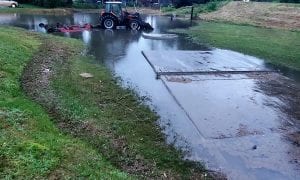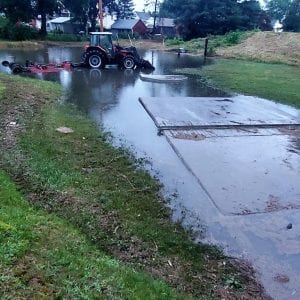WESTFIELD – The Flood Control Commission voted Wednesday to approve two contracts to fund engineering assessments of the city’s two flood control dams, awarding both contracts to a local engineering consult.
The board approved a $3,400 contract to develop a plan to mitigate a siltation problem at the outflow of the Powdermill Brook flood control dam.
City Engineer Mark Cressotti reported that the outflow of silt from the impoundment pond has raised the stream bed below the dam the dam.
“Over the years the impoundment pond has filled with silt, so instead of being held in the pond behind the dam, the silt is washing straight through,” he said.
The elevation of the stream bed has submerged a system of pipes, called toe drains, installed inside the earthen dam to drain water and stabilize the soil material of the dam.
“The toe drains are designed to wick water out of the dam material, keeping the dam dry and structurally sound,” Cressotti said.
“Now the toe drains are underwater, so they are saturating the base of the structure instead of draining water out of it,” Cressotti said. “At some point, the board will have to take action to lower the stem bed to remediate that problem. The engineering study will provide a plan to accomplish that work.”
The Flood Control Board also approved a second contract, of $5,600, to Tighe & Bond to conduct inspections of both the Powdermill and Armbrook dams, both of which were constructed shortly after the flood of 1955 when flood water carried in the two brooks caused extensive property damage to buildings at the base of the Clay Hill section of North Elm Street and Union Street area.
Cressotti said the state Department of Conservation and Recreation Office of Dam Safety requires a structural inspections and engineering reports. State regulations mandate that dam owners hire a qualified engineer to inspect and report results every 2 years for High Hazard Potential dams, every 5 years for Significant Hazard Potential dams and every 10 years for Low Hazard Potential dams.
Changes in the state dam safety regulations, enacted in 2002 under MGL Chapter 253, Sections 44-50 now require dam owners are to be responsible for registering, inspecting, reporting inspection results to the Office of Dam Safety and maintaining their dams in good operating condition.
High Hazard Potential dam refers to dams located where failure will likely cause loss of life and serious damage to home(s), industrial or commercial facilities, important public utilities, main highway(s) or railroad(s).
Significant Hazard Potential dam refers to dams located where failure may cause loss of life and damage home(s), industrial or commercial facilities, secondary highway(s) or railroad(s) or cause interruption of use or service of relatively important facilities.
Low Hazard Potential dam refers to dams located where failure may cause minimal property damage to others. Loss of life is not expected.








